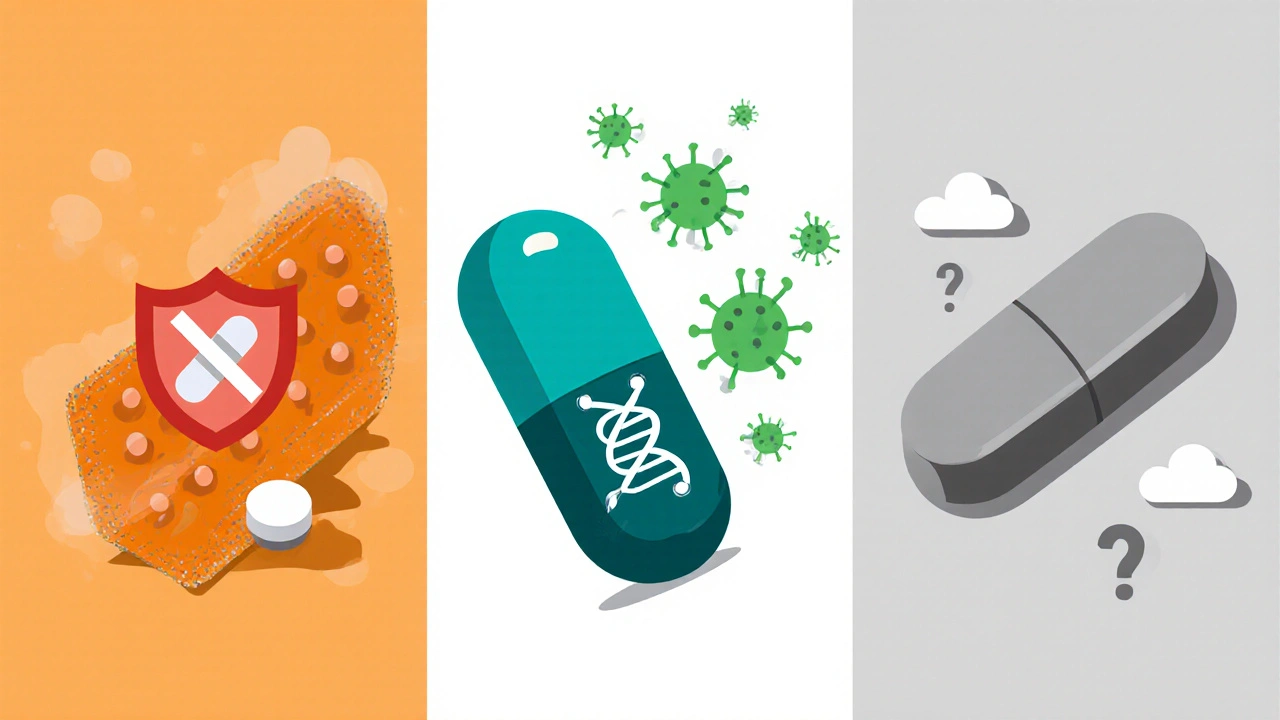Ivermectin vs Alternatives: Drug Selector Tool
When you hear the name ivermectin, the first thing that pops up is its reputation as a controversial COVID‑19 remedy. But the drug is actually a broad‑spectrum antiparasitic that’s been on the market for over four decades. If you’re trying to decide whether ivermectin-or one of its many look‑alikes-makes sense for a given condition, you need a side‑by‑side rundown of efficacy, safety, and regulatory standing. Below is a no‑fluff, real‑world comparison that helps you answer the most common questions.
TL;DR - Quick Takeaways
- Ivermectin is proven for helminth infections and some skin conditions; its COVID‑19 data remain inconclusive.
- Molnupiravir and Paxlovid have strong trial results for early COVID‑19, while doxycycline offers modest antiviral activity plus antibacterial coverage.
- Hydroxychloroquine and nitazoxanide are largely abandoned for COVID‑19 due to lack of benefit and safety concerns.
- All drugs have distinct dosing schedules; misuse can lead to serious side effects.
- Regulatory agencies (FDA, TGA, EMA) approve ivermectin for parasites, not for viral infections.
What Is Ivermectin?
Ivermectin is a broad‑spectrum antiparasitic medication that belongs to the macrocyclic lactone class. It was first approved in 1987 for veterinary use and later for human infections such as onchocerciasis (river blindness) and strongyloidiasis. The drug works by binding to glutamate‑gated chloride channels in parasites, causing paralysis and death. Its oral formulation is 3mg tablets, typically given as a single dose of 150-200µg/kg for most helminthic infections.
Beyond parasites, ivermectin gained global attention during the COVID‑19 pandemic after several observational studies suggested a possible reduction in disease severity. Large‑scale randomized trials, however, have not confirmed a meaningful benefit, and major health agencies continue to label its use for COVID‑19 as off‑label and investigational.
Key Alternatives to Consider
Below are the most frequently mentioned drugs that people compare to ivermectin, especially in the context of viral or parasitic illnesses.
- Doxycycline - a tetracycline antibiotic with broad antibacterial coverage and modest anti‑viral activity reported in early COVID‑19 studies.
- Hydroxychloroquine - an antimalarial once touted for COVID‑19 but now largely dismissed after multiple negative trials.
- Molnupiravir - an oral nucleoside analogue approved in 2022 for non‑hospitalized COVID‑19 patients at high risk.
- Paxlovid - a combination of nirmatrelvir and ritonavir that reduces hospitalization by ~89% when taken within five days of symptom onset.
- Nitazoxanide - an antiparasitic with some in‑vitro activity against SARS‑CoV‑2, but clinical evidence remains weak.
- Moxidectin - a newer macrocyclic lactone approved for onchocerciasis in some countries; still under evaluation for broader use.
- Fluvoxamine - an SSRI that showed reduced clinical deterioration in a small trial of early COVID‑19 patients.
Comparative Table: Efficacy, Safety, and Approved Uses
| Drug | Primary Indication | COVID‑19 Evidence (RCTs) | Common Side Effects | Regulatory Status (2025) |
|---|---|---|---|---|
| Ivermectin | Onchocerciasis, strongyloidiasis, other helminths | Major trials (e.g., TOGETHER) show no statistically significant benefit | Skin rash, nausea, dizziness; rare neurotoxicity at high doses | Approved for parasites; off‑label for COVID‑19 in most countries |
| Doxycycline | Bacterial infections, Lyme disease, malaria prophylaxis | Small studies suggest modest reduction in viral load; not definitive | Photosensitivity, gastrointestinal upset, esophagitis | Approved for bacterial infections; investigational for COVID‑19 |
| Hydroxychloroquine | Malaria, autoimmune disorders (RA, SLE) | Multiple RCTs show no benefit; some indicate increased cardiac risk | QT prolongation, retinopathy (long‑term), GI upset | Approved for malaria and rheumatology; withdrawn for COVID‑19 |
| Molnupiravir | Early‑stage COVID‑19 (high‑risk adults) | Reduces hospitalization by ~30% in final analysis | Diarrhea, nausea, possible mutagenicity (theoretical) | Approved in US, EU, UK for emergency use; prescription only |
| Paxlovid | Early‑stage COVID‑19 (high‑risk adults) | ~89% reduction in hospitalization/death in EPIC‑HR trial | Altered taste, diarrhea, drug‑drug interactions via ritonavir | Approved worldwide; prescription required |
| Nitazoxanide | Protozoal infections (Giardia, Cryptosporidium) | In‑vitro antiviral activity; clinical benefit unproven | Abdominal pain, headache, metallic taste | Approved for parasitic infections; off‑label for COVID‑19 |
| Moxidectin | Onchocerciasis (single‑dose regimen) | No large COVID‑19 trials; theoretical similarity to ivermectin | Fatigue, dizziness, rare hepatic events | Approved in EU for onchocerciasis; limited elsewhere |
| Fluvoxamine | Obsessive‑compulsive disorder, depression | TOGETHER trial showed 31% lower risk of clinical deterioration | Nausea, insomnia, sexual dysfunction | Approved for psychiatric use; off‑label for COVID‑19 in some regions |
How to Choose the Right Agent for a Given Condition
Think of drug selection like matching a key to a lock. First, ask yourself: what is the primary problem you need to solve?
- Parasitic infection? Ivermectin or moxidectin are the go‑to choices. They have decades of safety data and a clear dosing schedule.
- Early COVID‑19 in a high‑risk adult? Paxlovid is the most effective, followed by molnupiravir if ritonavir‑based interactions are a concern.
- Need antibacterial coverage plus a possible antiviral boost? Doxycycline can cover bacterial co‑infections and has moderate antiviral signals, but it’s not a substitute for proven antivirals.
- Looking for a cheap, over‑the‑counter option for mild symptoms? Many people still turn to ivermectin, but without strong evidence you risk side effects for little gain.
Always cross‑check the patient’s other medications. For instance, Paxlovid’s ritonavir component blocks CYP3A4, so it can cause dangerous spikes in statins or anticoagulants. In contrast, ivermectin isn’t a major CYP inhibitor, but high doses can cross the blood-brain barrier and cause neurotoxicity.

Safety Profiles and Common Pitfalls
Misusing any of these drugs can backfire. Here are the top mistakes to avoid:
- Self‑prescribing ivermectin for COVID‑19 - leads to overdoses (people sometimes take veterinary formulations, which are far stronger).
- Ignoring drug interactions with Paxlovid - forget to pause certain heart meds or adjust doses, and you could end up in the ER.
- Using hydroxychloroquine without cardiac monitoring - QT prolongation can trigger life‑threatening arrhythmias.
- Skipping the full course of doxycycline - incomplete treatment may breed resistant bacteria.
In all cases, a quick blood test for liver enzymes can catch early toxicity, especially with moxidectin or nitazoxanide.
Regulatory Landscape in 2025
Regulators have drawn clear lines:
- FDA (US) - Ivermectin approved only for specific parasitic diseases; Paxlovid and molnupiravir have Emergency Use Authorization (EUA) that became full approval in 2023.
- TGA (Australia) - Mirrors FDA stance; ivermectin can be obtained via prescription for parasites but not for viral infections.
- EMA (Europe) - Similar guidance; moxidectin approved for onchocerciasis in the EU, not for COVID‑19.
If a pharmacy advertises “ivermectin for COVID‑19” you’re likely looking at a non‑compliant vendor.
Practical Checklist Before Starting Any of These Drugs
- Confirm the exact diagnosis (parasitic vs viral vs bacterial).
- Check current meds for potential interactions (especially CYP450 substrates).
- Review renal and hepatic function labs; adjust dose if needed.
- Discuss pregnancy or breastfeeding status - many of these drugs are contraindicated.
- Ensure you have a reputable source: pharmacy‑dispensed prescription, not online black‑market.
Frequently Asked Questions
Frequently Asked Questions
Can ivermectin prevent COVID‑19 infection?
Current high‑quality randomized trials show no preventive benefit. Public health agencies advise against using it for prophylaxis.
Is Paxlovid safe for people on blood thinners?
Ritonavir can increase the levels of some anticoagulants. Doctors usually adjust the dose or monitor INR closely when prescribing Paxlovid together with warfarin.
Why do some users report feeling better after taking ivermectin?
Ivermectin can reduce parasite load, which may alleviate fatigue or skin symptoms. In COVID‑19 cases, perceived improvement often coincides with the natural disease course rather than a drug effect.
What dosage of doxycycline is used for COVID‑19 studies?
Most trials used 100mg twice daily for seven days, mirroring the standard bacterial infection regimen.
Are there any long‑term risks with repeated ivermectin use?
Repeated high‑dose use can lead to neurotoxicity, especially in patients with compromised blood‑brain barriers. For approved parasite courses, long‑term risk is low.
Bottom Line
If you need a proven antiparasitic, ivermectin (or its newer cousin moxidectin) remains the safest bet. For COVID‑19, the evidence now points firmly toward Paxlovid as the first‑line oral option, with molnupiravir as a backup. Doxycycline or nitazoxanide might make sense in very specific scenarios, but they’re not substitutes for the antivirals that have actually lowered hospitalizations. Always let a qualified health professional verify the indication, dosage, and interaction profile before you start any of these drugs.



Reading through the comparison reminds us that medicine is as much about context as chemistry. Ivermectin shines when the parasite burden is clear and the dosing is respected. For viral foes we now have options that have survived rigorous trials and saved lives. Keep in mind that choosing a drug is like choosing a tool – the right one fits the job perfectly. Stay hopeful and let the facts guide your health decisions.